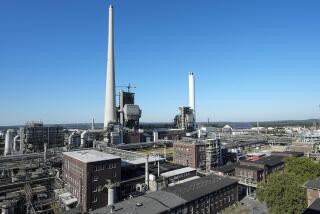Dresden: From Rubble to the East Bloc’s High-Tech Center
- Share via
DRESDEN, East Germany — After 1,000 Allied bombers had finished with Dresden on a night nearly 40 years ago this month, little was left.
On that night of Feb. 13-14, 1945, in the last weeks of World War II, one of Europe’s most beautiful cities was virtually destroyed in one of the most devastating non-nuclear air attacks ever. At least 35,000 people were killed and half a million others fled the firestorm touched off by the bombing.
“I never thought it could be a city again,” Erika Buhreg, a 64-year-old office worker, said recently, recalling her thoughts when she saw the extent of the destruction.
But Dresden has become a city again, and something more than the cultural center it was.
In addition to restoring the 18th-Century Zwinger Palace and museum, the Semper Opera House and other architectural riches of Dresden’s past, the Communist authorities have made the city of Richard Wagner and Richard Strauss a focal point for high-technology industry and the center of the most advanced non-military research being done in the Soviet Bloc.
“Dresden is now a scientific center,” Mayor Gerhard Schill boasted recently to a group of Western reporters.
Ironically, it was the absence of industry or other strategic activity that made the destruction of Dresden one of the most controversial Allied acts of the war. But today smokestacks break the skyline and the city architect, Heinz Michalk, talks proudly of integrating the new industry into the rebuilt city.
In many ways, the reconstruction of Dresden reflects the postwar recovery of East Germany itself, a country that despite enormous hardships imposed by its Soviet occupiers has come to play an increasingly important role in the Soviet Bloc’s industrial development.
In the key fields of communications equipment, computer-controlled machine tools, micro-electronics and optics, East Germany is the acknowledged leader among Moscow’s allies and an important economic partner of the Soviet Union.
The Soviets’ need to modernize has become increasingly urgent, and in light of U.S. and other Western governments’ restrictions on the flow of high technology into the Soviet Bloc, East Germany’s technical expertise has come to be of growing importance to Moscow.
Here in Dresden, the Communist authorities have concentrated on electronics hardware and software development, including main-frame computers, advanced micro-circuitry and industrial robots, all areas of intense interest to the Soviets.
The Manfred von Ardenne Institute, a rare private research institute in the state-controlled economy, is situated here. Its 200 scientists are working in medical, micro-electronic and electro-mycroscopy research.
A recent report issued by the Paris-based Organization for Economic Cooperation and Development linked a sharp increase in East Germany’s production of sophisticated manufactured goods directly to export restrictions on corresponding Western products. The same study forecasts that much of this new technology will be exported to the Soviets.
Soviet Bloc economic analysts in West Berlin and Bonn believe that, as Western sources dry up, East Germany will be pressed to provide a growing volume of high-quality, high-technology products.
West German officials note that the Soviets and East Germans are already working together on a project in the electro-data processing field, and they expect other cooperative research to follow.
Karl-Heinz Gross, a specialist on the East German economy in the West German Ministry of Economics, said the Soviets “are definitely increasing their demands” on East Germany.
This intensified Soviet pressure was especially apparent at last summer’s summit conference of Comecon, the Soviet Bloc’s economic community. There, Moscow demanded more of East Germany’s highest-technology products for its own industry. But Moscow’s eagerness for East German technology is tempered by inherent suspicion and there are signs that the Soviets would not like to see one of its satellites acquire a significant technical advantage.
For now, though, East German performance still lags considerably behind the West’s. Western experts believe that in particularly sensitive areas, such as computer hardware, the East Germans are about five years behind.
East German officials admit this. They say that restricted access to Western technology has forced them to intensify their own research and development in order to produce things that in the past they were able to get from the West.
East Germany is already the Soviet Union’s No. 1 trading partner and it appears likely that the quality of this trade will be stepped up in the years ahead.
“East Germany is setting the standards in the East Bloc, and that includes the Soviet Union, if you exclude the military,” Gross, the specialist on East German economic affairs, said. In the West, breakthroughs in military research often find their way into civilian areas, but not in the East.
East Germany’s role in Eastern Europe is much different from what Moscow originally envisaged. In the first three years after World War II, Soviet occupation troops dismantled and shipped to the Soviet Union between $2.5 billion and $3 billion worth of German industrial equipment, everything from railroad tracks to complete factories.
Only when Moscow had trouble running the plants efficiently did it discontinue this policy and start investing directly in the conquered territory. Beginning in the mid-1950s, factories that had been seized were turned over to the East German government and they became the core of the country’s industrialization.
In pre-war Germany, there was little industry in the area around Dresden itself, but what is now East Germany had a rich tradition of precision engineering. Raw steel and chemicals produced in the western regions of pre-war Germany were brought here to be turned into machine tools, precision instruments and ceramic products. The tradition that was established here helped in East Germany’s reconstruction.
Less than half the size of West Germany, the Communist East had little choice but to rebuild its industry in its few large cities, including Dresden. Today its per-capita industrial output and its standard of living is roughly 60% of West Germany’s, but it leads the Soviet Bloc, including the Soviet Union, in both categories.
As in West Germany, time and economic growth have all but erased the scars of World War II. On Feb. 14, the 40th anniversary of the destructive air raid, Dresden will reopen the opulent Semper Opera House, which has been restored at a cost of $100 million.
There is even some discussion of rebuilding the Church of Our Lady, the skeletal remains of which were left untouched as a reminder of the night that the city almost died.
“There have been meetings about it,” city architect Michalk said. “Most people want the church to be restored, and someday it probably will be.”
More to Read
Sign up for Essential California
The most important California stories and recommendations in your inbox every morning.
You may occasionally receive promotional content from the Los Angeles Times.













